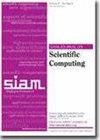具有各种初始分布的随机动力系统的伪逆转归一化流程
IF 2.6
2区 数学
Q1 MATHEMATICS, APPLIED
引用次数: 0
摘要
SIAM 科学计算期刊》,第 46 卷第 4 期,第 C508-C533 页,2024 年 8 月。 摘要。我们提出了一种伪可逆归一化流方法,用于高效生成具有各种初始分布的随机微分方程(SDE)的状态样本。其主要目的是构建一种精确高效的采样器,可用作计算成本高昂的 SDE 数值积分的代用模型,如粒子模拟中使用的代用模型。经过训练后,归一化流模型可以直接生成 SDE 最终状态的样本,而无需模拟轨迹。现有的 SDE 归一化流模型依赖于初始分布,这意味着当初始分布发生变化时,模型需要重新训练。我们的归一化流模型的主要新颖之处在于它可以学习状态的条件分布,即以任意初始状态为条件的最终状态分布,因此模型只需训练一次,而且训练后的模型可用于处理各种初始分布。在研究最终状态如何随初始分布变化时,这一特点可以大大节省计算量。此外,我们还建议使用伪可逆网络架构来定义归一化流模型,它具有足够的表达能力和训练效率,适用于科学和工程领域的各种 SDE,例如粒子物理学。我们用 Kullback-Leibler 发散度量对伪可逆归一化流模型到目标概率密度函数进行了严格的收敛分析。我们还提供了数值实验来证明所提出的归一化流动模型的有效性。计算结果的可重复性。本文被授予 "SIAM 可重复性徽章":代码和数据可用",以表彰作者遵循了 SISC 和科学计算界重视的可重现性原则。读者可以通过 https://github.com/mlmathphy/PRNF 和补充材料(PRNF-main.zip [27.4MB])中的代码和数据重现本文的结果。本文章由计算机程序翻译,如有差异,请以英文原文为准。
A Pseudoreversible Normalizing Flow for Stochastic Dynamical Systems with Various Initial Distributions
SIAM Journal on Scientific Computing, Volume 46, Issue 4, Page C508-C533, August 2024.
Abstract. We present a pseudoreversible normalizing flow method for efficiently generating samples of the state of a stochastic differential equation (SDE) with various initial distributions. The primary objective is to construct an accurate and efficient sampler that can be used as a surrogate model for computationally expensive numerical integration of SDEs, such as those employed in particle simulation. After training, the normalizing flow model can directly generate samples of the SDE’s final state without simulating trajectories. The existing normalizing flow model for SDEs depends on the initial distribution, meaning the model needs to be retrained when the initial distribution changes. The main novelty of our normalizing flow model is that it can learn the conditional distribution of the state, i.e., the distribution of the final state conditional on any initial state, such that the model only needs to be trained once and the trained model can be used to handle various initial distributions. This feature can provide a significant computational saving in studies of how the final state varies with the initial distribution. Additionally, we propose to use a pseudoreversible network architecture to define the normalizing flow model, which has sufficient expressive power and training efficiency for a variety of SDEs in science and engineering, e.g., in particle physics. We provide a rigorous convergence analysis of the pseudoreversible normalizing flow model to the target probability density function in the Kullback–Leibler divergence metric. Numerical experiments are provided to demonstrate the effectiveness of the proposed normalizing flow model. Reproducibility of computational results. This paper has been awarded the “SIAM Reproducibility Badge: Code and data available” as a recognition that the authors have followed reproducibility principles valued by SISC and the scientific computing community. Code and data that allow readers to reproduce the results in this paper are available at https://github.com/mlmathphy/PRNF and in the supplementary materials (PRNF-main.zip [27.4MB]).
Abstract. We present a pseudoreversible normalizing flow method for efficiently generating samples of the state of a stochastic differential equation (SDE) with various initial distributions. The primary objective is to construct an accurate and efficient sampler that can be used as a surrogate model for computationally expensive numerical integration of SDEs, such as those employed in particle simulation. After training, the normalizing flow model can directly generate samples of the SDE’s final state without simulating trajectories. The existing normalizing flow model for SDEs depends on the initial distribution, meaning the model needs to be retrained when the initial distribution changes. The main novelty of our normalizing flow model is that it can learn the conditional distribution of the state, i.e., the distribution of the final state conditional on any initial state, such that the model only needs to be trained once and the trained model can be used to handle various initial distributions. This feature can provide a significant computational saving in studies of how the final state varies with the initial distribution. Additionally, we propose to use a pseudoreversible network architecture to define the normalizing flow model, which has sufficient expressive power and training efficiency for a variety of SDEs in science and engineering, e.g., in particle physics. We provide a rigorous convergence analysis of the pseudoreversible normalizing flow model to the target probability density function in the Kullback–Leibler divergence metric. Numerical experiments are provided to demonstrate the effectiveness of the proposed normalizing flow model. Reproducibility of computational results. This paper has been awarded the “SIAM Reproducibility Badge: Code and data available” as a recognition that the authors have followed reproducibility principles valued by SISC and the scientific computing community. Code and data that allow readers to reproduce the results in this paper are available at https://github.com/mlmathphy/PRNF and in the supplementary materials (PRNF-main.zip [27.4MB]).
求助全文
通过发布文献求助,成功后即可免费获取论文全文。
去求助
来源期刊
CiteScore
5.50
自引率
3.20%
发文量
209
审稿时长
1 months
期刊介绍:
The purpose of SIAM Journal on Scientific Computing (SISC) is to advance computational methods for solving scientific and engineering problems.
SISC papers are classified into three categories:
1. Methods and Algorithms for Scientific Computing: Papers in this category may include theoretical analysis, provided that the relevance to applications in science and engineering is demonstrated. They should contain meaningful computational results and theoretical results or strong heuristics supporting the performance of new algorithms.
2. Computational Methods in Science and Engineering: Papers in this section will typically describe novel methodologies for solving a specific problem in computational science or engineering. They should contain enough information about the application to orient other computational scientists but should omit details of interest mainly to the applications specialist.
3. Software and High-Performance Computing: Papers in this category should concern the novel design and development of computational methods and high-quality software, parallel algorithms, high-performance computing issues, new architectures, data analysis, or visualization. The primary focus should be on computational methods that have potentially large impact for an important class of scientific or engineering problems.

 求助内容:
求助内容: 应助结果提醒方式:
应助结果提醒方式:


